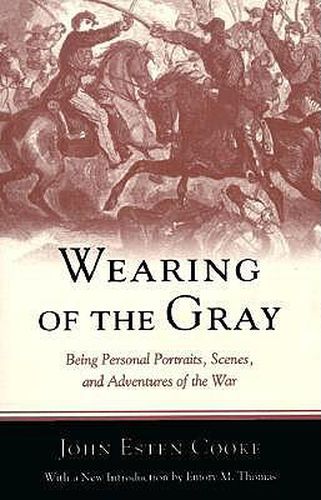Readings Newsletter
Become a Readings Member to make your shopping experience even easier.
Sign in or sign up for free!
You’re not far away from qualifying for FREE standard shipping within Australia
You’ve qualified for FREE standard shipping within Australia
The cart is loading…






John Esten Cooke was a writer, not a fighter, and yet he enjoyed (in every sense of the word) a remarkable and extensive Civil War career that took him from John Brown’s raid to General Lee’s surrender and put him in close touch with some of the greatest commanders in American history, most notably his much-admired cousin-in-law, J. E. B. Stuart. Wearing of the Gray, published in 1867, contains Cooke’s best writing on the war, sparkling vignettes that display an excellent eye for local colour and the picaresque, a wry sense of humor, and a quick grasp of character. It includes eleven vivid portraits of both famous figures, such as Stuart, Stonewall Jackson, P. G. T. Beauregard, John Singleton Mosby, and Jubal Early, and less famous, as well as stories and sketches based on Cooke’s experiences.
Though Cooke tends to romanticize the past, as evinced in his merry rendition of Stuart’s cavalry campaign in the summer of 1863, an event most participants remembered as nightmarish, he is equally capable, for example, of capturing with moving and stark simplicity what the surrender at Appomattox meant to the Confederates present there. In sum, Cook’s unique pairing of advantaged military perspective and authorial talent
give his wartime sketches a combination of validity and vitality almost unmatched in the literature of the Civil War
(Civil War History).
$9.00 standard shipping within Australia
FREE standard shipping within Australia for orders over $100.00
Express & International shipping calculated at checkout
John Esten Cooke was a writer, not a fighter, and yet he enjoyed (in every sense of the word) a remarkable and extensive Civil War career that took him from John Brown’s raid to General Lee’s surrender and put him in close touch with some of the greatest commanders in American history, most notably his much-admired cousin-in-law, J. E. B. Stuart. Wearing of the Gray, published in 1867, contains Cooke’s best writing on the war, sparkling vignettes that display an excellent eye for local colour and the picaresque, a wry sense of humor, and a quick grasp of character. It includes eleven vivid portraits of both famous figures, such as Stuart, Stonewall Jackson, P. G. T. Beauregard, John Singleton Mosby, and Jubal Early, and less famous, as well as stories and sketches based on Cooke’s experiences.
Though Cooke tends to romanticize the past, as evinced in his merry rendition of Stuart’s cavalry campaign in the summer of 1863, an event most participants remembered as nightmarish, he is equally capable, for example, of capturing with moving and stark simplicity what the surrender at Appomattox meant to the Confederates present there. In sum, Cook’s unique pairing of advantaged military perspective and authorial talent
give his wartime sketches a combination of validity and vitality almost unmatched in the literature of the Civil War
(Civil War History).